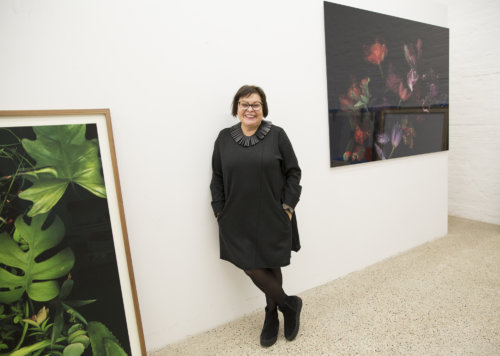
For Luzia Simons, Technology and Nature Are A Bridge To Art
There is a lush, vivid beauty to Luzia Simons’ work, an organic liveliness at odds with her chosen medium: the scanner. On the surface, scanners are an empty mode of reproduction, simply producing two-dimensional copies. But Simons comes from a background of photography, and brings to her scanned prints a dynamic, thought-provoking intensity.
“There was a scanner in my laboratory that was used to scan analog films,” Simons recounted to GC of her time teaching photography in Stuttgart, German. “I thought I had to do something with it. It even forced me to do something with it. So, I first put everything possible on the scanner to capture the colors. Objects, pigments, but also natural elements like meat, fruit, and sausage. At some point I bought tulips and experimented with them…Very profound images came out of it. When I showed them to my husband, he said, ‘What do you want with that at the end of the 20th century? This has already been done so much.’ Initially I thought he was right so I left them for five years in the drawer.”
The aftermath of 9/11, however, made Simons reconsider. “Many think of the tulip and Holland together, but it was cultivated for centuries much earlier in the Middle East… It was only in the 16th century that the tulip came to Central and Western Europe. The tulip mania then triggered the world’s first stock market crash in 1637… I saw a way to reflect on the relationship through an object connecting the Occident and the Orient, but seen from both sides in different ways.”
In the years since, Simons has continued to produce the beautiful, grand scale botanical works, and has continued to innovate, finding new ways of adapting this visual language of flowers to the world around her. Her latest work takes a more personal approach, examining her own global experience in the context of borders and exploration.
“This time, it is about my life in two hemispheres,” Simons reflected. “The exhibition is not finished yet– it is still in the development process. The starting point is a postcard from 1904 titled “Fotografía Alemánn”. It shows the jungle of my native Brazil, portrayed by a German photographer. A personal bridging– but also related to the beginnings of photography and the exploration of South-American nature by German scientists, such as Alexander von Humboldt… It lets me experiment again.”
For more information on Luzia Simons’ work and commissions, visit the artist’s website.



































